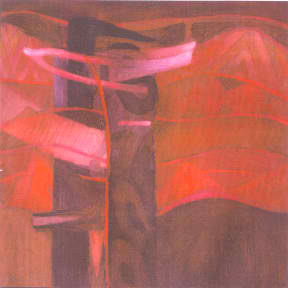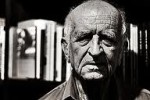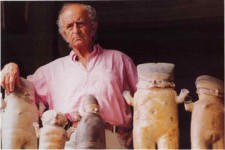
Fernando de Szyszlo
Peruvian, 1925-2017
Mar de Lurin, 1989
acrylic on canvas
39 1/2 x 39 1/2 in.
SBMA, Gift of Jerry and Mary Kay Gardner
1997.73

Fernando de Szyszlo, photo by Cesar Becerra, May 28, 2010
Fernando de Szyszlo stated: “If you want me to tell you who I am, then I will answer like Ortega y Gasset: 'I am myself and my circumstances. I am the result of what I have lived; a result of my country, which is what substantially formed me.' There I spent my childhood and adolescence. When as an adult I went to Poland to see if there was something that called to the blood in me from my father’s side, I realized that the language with which one names the world is what principally defines you. My language is my land; I am a Peruvian. Patriotism emerges form the culture one has lived in.” (Colle)
RESEARCH PAPER
Fernando de Szyszlo was born to a Polish father and Peruvian mother in Lima Peru July 5, 1925. He currently lives with his wife, Lila, and has his studio, in New York City. A painter and teacher, he studied architecture before transferring in 1944 to the Escuela de Artes Plasticas at the Pontificia Universidad Catolica del Peru in Lima, where he was taught by Adolf Winternitz (b 1906), under whom he developed a vigorous and poetic abstract style. In 1948 he went to Paris, holding his first exhibition there the following year. He spent the next few years in Paris and Florence, absorbing the influence of Leonardo and Rembrandt, as well as that of Picasso and other leading 20th-century artists, and developing a style that combined abstraction with Pre-Columbian themes and forms expressed in bright colors.
In 1951 Szyszlo returned to Lima, where his abstract style was something of a novelty. Following the establishment in the mid-1950s of the Instituto de Arte Contemporaneo in Lima, he formed the group Espacio to help promote contemporary art, attempting to encourage links between the universal approach of abstract art and the national Indigenist style. He expressed this synthesis in such paintings as Cajamarca (1959; Washington, DC, Mus. Mod. A. Latin America), while in others he used Quechuan titles to affirm his cultural heritage. During the '50s and '60s, while a professor at Catholic University, where he taught until 1977, Szyszlo began to establish the themes which would dominate his career to the present day, including his "Casa" and "Paisaje" (landscape) series.
"Interiors," a 1972 series of gouaches and watercolors in which the artist fused European internationalist trends with his native lyrical or sometimes almost funereal temperament, marked a turning point. He achieved an international reputation, with exhibitions worldwide, and visiting professorships in several North American universities. His work was enormously influential on 20th-century Peruvian art. A major retrospective of his work was held in 1976 at the exhibition hall of Petroperu, Lima. He discontinued painting, and created only sculpture for a short time, but resumed painting.
THE PAINTING:
MAR DE LURIN 1989. 149.8x149.2cm. The title of this painting although seemingly clear is not. The subject matter is a non-representational depiction of the “Mar” (Sea), “Mar of Lurin” in Peru, however, there is not an actual “Sea” of Lurin, rather it is simply a “geographical area”, and a desert! The Lurin Valley is a desert area south of Lima on the Pacific Ocean side. De Szyszlo did a series of the “Sea of Lurin”. Peru’s land, sky and sea are the inspirational forces for De Szyszlo’s lyrical abstractions. The artist, in a 1994 interview states: “In each case the title has come afterwards, I do not try to find forms which explain a title but rather forms which in turn suggest their own title. In general they are a set of aggressive forms which are like daggers or the beaks of birds. This violence is consonant with a general pattern with which I have been working for a long time, in which there are both birds and angels.” Pre-Columbian art, however, provides the artist with an equally rich source for abstract form. De Szyszlo’s canvas size and square shape add to a feeling of mass. The massive interlocking painted shapes echo ancient Andean architecture; his colors pay homage to Paracas textiles; and his black patterns allude to Moche painting. De Szyszlo’s structured pictorial space and saturated planes of color also reflect the artists’ sophisticated knowledge of international abstract painting from the post-World War II period. The painting is done in acrylic as he used only acrylics after 1965 in order to maintain the pastiness of oil without its fragility. The painting is reminiscent of the European modernists and of OKeeffe and Dove by simplification of forms and getting to the “essence” of the subject. This painting is “symbolic” of the power of nature, a universalistic view of the sea as something greater than our selves.
De Szyszlo paints in a Non-representational, European Abstract style, with “indigenous” Peruvian, Mayan or Pre-Columbian influence and pre-Hispanic culture from which he uses architectural shapes, forms, and patterns. The front vertical images in the piece appears in many of De Szyszlo’s works, abstracted from the ancient Mayan architectural style.
A strong composition and colors of the subject elements assist in creating a strong piece. De Szyszlo is above all a colorist. The colors seem to intentionally “vibrate” optically because of the application technique of layering of colors over a white ground, and the layering of many transparent glazes of pigments. He copied this technique from the great painting “masters”. The painting is primarily dark with a wide range of value. There are light areas but no clearly defined light source. He chooses a palette of mostly monochromatic deep reds, with violet and magenta accents and earth tones. Some shapes such as those on the left side of the painting (“wishbone”, and other bands) are almost white, heavily textured.
Two massive verticals in the foreground and mid-ground divide the painting in half and are in a dark value. Some shapes at the left upper and lower part of the painting are light, almost white, and heavily textured. The background shapes are a medium value, and a clearer palette of reds and other colors. Some lines and edges are diffused; the thinnest lines are clearly defined in pure, bold reds. De Szyszlo used an impasto technique and heavily textured brush strokes on selected shapes. There are bands of undulating horizontals in the background, in a medium value, with lots of pattern. Look closely; there are also shapes within shapes, many hidden, some geometric. The color techniques, direction and numbers of undulating shapes and lines, and texture, contribute to the tension and movement.
CONCLUSION:
As a surrealist, he was involved with both studying and depicting the unconscious, and the use of symbols in his work. This painting is an excellent example of that tradition. The shapes used symbolize Mayan architecture as well as the sea, waves and motion, and land of the Lurin Valley. Strong elements of light and shadow symbolize solitude. This work could be done as a textile, or as decoration on pottery or other native objects. He understood paradox and there is balance and turbulence, simplicity and complexity, in this painting.
The 1989 Sea of Lurin is dramatic in the following ways: the size and shape, the richness of the palette, the force of the strong design elements including use of bold forms, depth of light and shadow and intense color applied in layers. Fernando de Szyszlo’s techniques create a painting that cannot easily be forgotten, expressing a Peruvian subject matter in a non-representational style.
BIBLIOGRAPHY:
Colle, Marie-Pierre. Latin American Artists in Their Studios. Introduction by Carlos Fuentes. A Hines Edition Book. The Vendome Press New York, New York. 1994. ISBN: 0-86565-957-5 Chapter pages: 168-177 Wild, E.A. c1991. Bogotá, Colombia.
Fernando de Szyszlo. ISBN: 9589532713
V. Fraser and O. Baddeley: Drawing the Line: Art and Cultural Identity in Contemporary Latin America. (London, 1989), pp. 36-8
Turner, Jane, ed. Dictionary of Art Online. NY: Groves Dictionaries, Inc., 1996.
Peer reviewed journal.
Art Nexus. Art Nexus no. 11 (January/March 1994). P.210-2. ISSN: 0120-713X. Medina, Alvaro. Fernando de Szyszlo. Interview.
Por Marielal Balbi, Prologo de Mario vargas Llosa. Szyszlo: Travesia.
ISBN 9972-676-46-3
Museum of Latin American Art. LA weekly Aug 13-19. Article by Cynthia Mac Mullin, Director of Collections and Exhibitions, (internet)
http://www.museum.oas.org/permanent/abstraction/szyszlo/writings_by.html
Biography: J. Villacorta Paredes: Pintores peruanos de la Republica (Lima, 1971), pp. 106-9; J. A. de Lavalle and W. Lang: Pintura contemporanea, Coleccion arte y tesoros del Peru, ii (Lima, 1976), pp. 150-55; V. Fraser and O. Baddeley: Drawing the Line: Art and Cultural Identity in Contemporary Latin America (London, 1989), pp. 36-8
Biography: Subject: Fernando de Szyszlo at Associated American Artists.(NY, NY. Fernando de Szyszlo at Associated American Artists.(New York, New York)(Review of Exhibitions). Gerrit Henry. Art in America. Criticism and interpretation. March 1995 v83 n3 p107(2). IS n3. LW p107(2). ND 20031117. OT (New York, New York)(Review of Exhibitions). PB Brant Publications, Inc
Prepared for the SBMA Docent Council by Mooneen Mourad, March 26, 2004

1998 Photograph of de Szyszlo with objects from his collection of pre-Colombian art.
SBMA CURATORIAL LABELS
In Paris during the 1950s, Szyszlo studied art and befriended such luminaries as the Mexican poet Octavio Paz, Mexican painter Rufino Tamayo, and Colombian muralist Alejandro Obregón. He also learned about Surrealism and its conjuring of the deep past and the ghosts of the unconscious. These experiences prompted him to use abstraction to express the troubled history of Peru. At the time, abstract art was seen as yet another European and American cultural imposition, and Szyszlo initially attracted intense criticism from Peruvian artists and intellectuals.
In 1988, he wrote: “To work and try to create in Latin America, we live exhausted by the worst characteristics of the 20th century without having yet surpassed the darkest conditions of the 19th century.” This painting shows how he negotiated that impossible position. Lurin is a region of Peru where desert mountains meet the sea, and the interlacing of waves and triangles evokes that intersection. The ribbons and strands of paint act like the woof and weft of a loom to weave this image into existence. Perhaps this reflects the artist’s fascination with Peru’s extraordinary textile traditions, including those of the Quechua, Inca, Chancay, and Moche peoples, which predate Spanish colonization and remain vital in the 21st century.
- Going Global, 2022
Peru’s land, sky, and sea are the primary sources for Fernando de Szyszlo’s lyrical abstractions. In particular, pre Columbian art, of which he is an avid collector, provides the artist with a rich source of abstract forms. Szyszlo’s massive, interlocking shapes echo ancient Andean architecture; his colors pay homage to Paracas textiles; and his patterns allude to Moche painting.
Mar de Lurín depicts abstract forms inspired by the Lurín Valley nestled on the coast of Peru, 25 miles south of present day Lima. Szyszlo has maintained a small house and workshop in Lurín, a place he has described as “a desolate and mysterious desert” meeting dramatically with the Pacific Ocean. Inhabited for over 3,000 years, the Lurín Valley region has been an enduring subject in Szyszlo’s paintings and works on paper beginning in the late 1980s into the ’90s.
- SBMA title card, 2013
As Peru’s premier abstract painter, Fernando de Szyszlo has played a critical role in the development of abstraction in Latin America. Since his first exhibition of abstract paintings in Lima in 1951, he has been an important catalyst for a constructive dialogue between local traditions and international trends.
Peru’s land, sky, and sea are the inciting references for the evocative fields of color that comprise his lyrical abstractions. Pre-Columbian art, however, provided the artist with an equally rich source for abstract form. De Szyszlo’s massive, interlocking forms echo ancient Andean architecture; his colors pay homage to Paracas textiles; and his black patterns allude to Moche painting. At the same time, de Szyszlo’s structured pictorial space and saturated planes of color elicit the poetry of abstraction, reflecting the artist’s sophisticated knowledge of 1960s and 1970s international painting.
- SBMA Wall Text, 2000

The underpainting in Szyszlo’s works instructs us on his process. When he began to use acrylics, for the color and gloss, he lost the texture of oil paint. The acrylic flattened out like nail polish, great for all the layers of glazing with which he enriched his work, a gift of his studies of the old masters in Europe, but obliterating the sense of the brush. By applying brush strokes in wax or other composites over the basic images, and glazing in acrylic over these raised strokes, he was able to add depth and shadow, revealing shapes and images shimmering beneath the surface of the painting. These effects are readily observable in our Mar de Lurin, 1989.